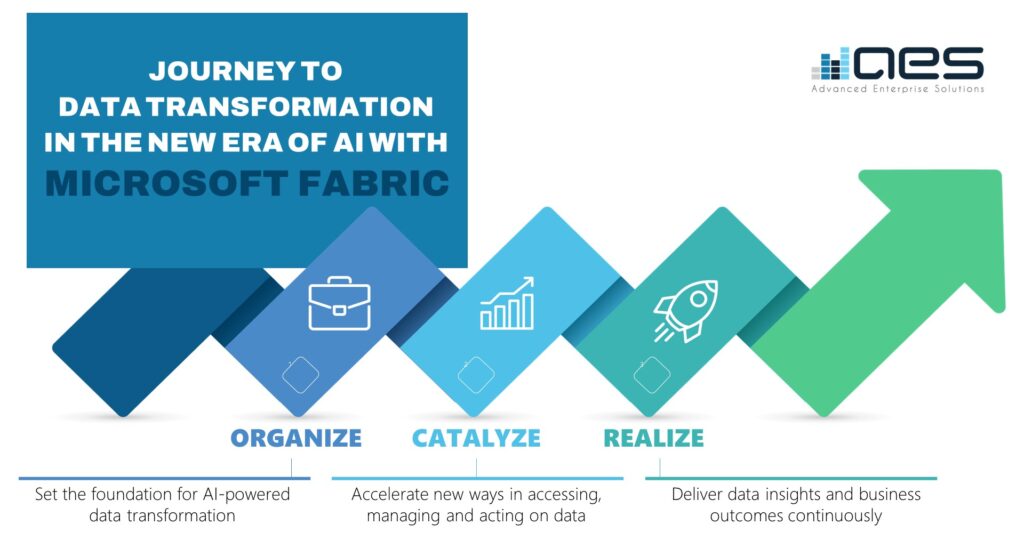The AES Group, in partnership with Playtime Solutions, has crafted a robust and comprehensive approach to help organizations resolve their data challenges, move to Microsoft Fabric and usher into their new AI-powered businesses. The Catalyze stage is the second crucial step in implementing Microsoft Fabric where we accelerate new ways in accessing, managing and acting on data by maximizing the capabilities of Microsoft Fabric while adopting proven tools, guides and templates.
Organizations need to an incremental approach during the Catalyze stage to get familiar with Microsoft Fabric’s capabilities while minimizing disruption to existing workflows and systems. This strategic adoption consists of breaking down the implementation into manageable stages, ensuring teams learn from each stage of implementation. adapting any effective team strategies into their ongoing use of Microsoft Fabric, and ensuring the implemented solution aligns closely with their business objectives.

Our Recommended Architecture
When implementing Microsoft Fabric, we highly recommend the Medallion Architecture, Data Mesh and a Hub & Spoke architecture.
What is Medallion Architecture?
Medallion Architecture is a data modeling framework that organizes data into three layers: Bronze, Silver, and Gold. The Bronze layer is the raw data landing zone, storing unprocessed data in its original format for historical tracking. The Silver layer cleanses and standardizes this data, performing tasks like deduplication and data type conversion to prepare it for analysis. The Gold layer offers business-ready, refined data optimized for specific use cases, featuring aggregated tables and de-normalized structures for fast querying. This layered approach enhances data quality, reusability, and maintainability, making it ideal for modern data platforms and analytics.
What is Data Mesh?
Data Mesh is a decentralized data architecture that treats data as a product and promotes domain-oriented ownership and distributed governance. In this model, data is organized by domains aligned with business functions or product lines, with each domain handling the full lifecycle of its data products, including sourcing, processing, and delivery. This approach enhances data quality, reduces bottlenecks, and boosts organizational agility by distributing responsibility and ownership across teams.
What is Hub & Spoke Architecture?
Hub & Spoke Architecture, often paired with Data Mesh, organizes distributed data systems by designating a central ‘hub’ for governance, security, and shared services, with ‘spokes’ representing individual domains or data products. The hub ensures cross-domain data sharing, enforces global policies, and supplies common infrastructure, while spokes retain autonomy over their data management. This model combines centralized control with domain-specific flexibility, allowing organizations to scale data operations efficiently while maintaining consistency and interoperability.
5 Steps in the Catalyze Stage
The step-by-step approach in the Catalyze stage supports progressive integration, continual learning, and adjustment throughout the Microsoft Fabric adoption journey, ultimately leading to a successful and sustainable implementation.
1 |
Pilot Project |
|
|
In the Catalyze stage, starting with a small-scale pilot project allows you to test Microsoft Fabric’s capabilities and address issues before full deployment. Begin by defining the pilot project scope with a specific use case or department to achieve quick wins and create momentum. Assemble a cross-functional team, including IT, data specialists, and business users, to ensure a smooth pilot. Lastly, establish clear success metrics to evaluate outcomes and apply insights to broader implementation.
|
||
2 |
Data Migration |
|
|
Migrating company data to OneLake is another vital step. While alternatives like shortcuts and mirrors may work in specific cases, using OneLake as the primary landing point for all analytical data offers long-term benefits. The process involves planning the migration from existing systems, cleansing and standardizing data to ensure quality, and validating data integrity through thorough post-migration checks.
|
||
3 |
Integration |
|
|
Microsoft Fabric requires integration with existing systems and data sources to establish a unified data ecosystem. This process includes setting up connectors for on-premises and cloud-based data sources, creating data pipelines to enable seamless data flow between systems, and rigorously testing these integrations to ensure they do not disrupt current operations.
|
||
4 |
Training and Enablement |
|
|
The Catalyze Stage depends on interconnection with existing systems and data sources to create a unified data ecosystem. You must have a structured training program that includes role-based training tailored to user groups like data analysts and IT admins, aligned with certifications such as DP:600 Fabric Analytics Engineer Associate and DP:700 Fabric Data Engineer Associate. Practical workshops allow users to interact and experiment with real organizational data safely, while a knowledge base, user guides, and support channels provide ongoing assistance for Fabric users.
|
||
5 |
Governance Implementation |
|
|
Maintaining data integrity and compliance in Fabric requires a robust governance framework during the Catalyze stage. This includes enforcing data access and usage policies, setting up monitoring and auditing tools to track data access and usage, and creating a metadata-rich data catalogue to ensure data assets are easily discoverable and understandable.
|
What’s Next For Your Enterprise
The AES Group, in partnership with Playtime Solutions, can help you overcome your data obstacles with our three-stage data transformation roadmap powered by Microsoft Fabric – no matter where you are on your journey.
- READY TO EXPLORE? – We can proceed with our complimentary two-hour data modernization ideation workshop to explore the unique challenges of your data environment and explore how Microsoft Fabric can help solve your most critical issues.
- READY TO EVALUATE? – We can conduct a three-day readiness assessment to review your data technologies, regulatory requirements and data management program to confirm need, assess readiness and identify risks in migrating to Microsoft Fabric.
- READY TO MIGRATE? – We can deliver a robust and adaptive Microsoft Fabric migration blueprint and validate it with POC(s) in four to eight weeks with FabricReady, Playtime Solutions’ proprietary administration, governance, secure and data mesh accelerator,
Let’s connect and explore your next steps in your data transformation journey.
